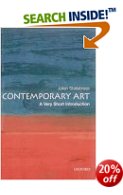New movements in art 1989—2005
Contemporary art has hardly ever been as notorious as it is today. We need all the help we can get in understanding sharks pickled in formaldehyde, unmade beds, paintings which feature elephant dung, and people having live cosmetic surgery as a form of performance art. Julian Stallabrass clearly knows this world and what is going on in it, and his book is a spirited attempt to situate and explain work which is breaking every known boundary. You’ll have to be prepared for an introduction which is largely devoted to a study of contemporary politics and economics, because he clearly believes that these have a direct effect on art via the close connections between art galleries, museums, and exhibitions and investors from the corporate world.
 These are the people he believes are controlling the art world today. He covers performance art, painting, sculpture, installations, and mixed media, no matter how bizarre. But the problems is that he tends to analyse works in relation to what motivated the artist – political protest, social outrage – making no attempt to say how valuable they are artistically. And most of his argument is posed in the form of abstract generalisations. This has the effect of holding the reader a long way off, remote from the art itself.
These are the people he believes are controlling the art world today. He covers performance art, painting, sculpture, installations, and mixed media, no matter how bizarre. But the problems is that he tends to analyse works in relation to what motivated the artist – political protest, social outrage – making no attempt to say how valuable they are artistically. And most of his argument is posed in the form of abstract generalisations. This has the effect of holding the reader a long way off, remote from the art itself.
One of his central arguments is that art is gradually merging with fashion and advertising. But this claim is founded on two weaknesses. The first is that he takes the claims of all the artists at face value without any attempt at critical evaluation. The second is that he doesn’t make any attempt to place his examples in any sort of historical perspective.
The latter part of the book deals with the relationship between art and money, and the current state of art criticism. He has some interesting revelations to make about price fixing, corporate investment, and secret deals as a means of inflating reputations – and we feel no shame in the schadenfreudliche thrill of learning that some speculators have lost their shirts to the tune of 99 percent on their original investment.
One other feature struck me as odd or unconvincing. It’s that many of the examples he discusses are ‘projects’ which are clearly forms of political activity. Not just propaganda, but demonstrations, protests, and even theoretical discussions masquerading as works of art.
I was glad to see that he concluded with examples of Internet art, but once again, because of his bias in favour of protest, most of the sites had been closed down by the time I came to check them.
© Roy Johnson 2006
Julian Stallabrass, Contemporary Art: A Very Short Introduction, Oxford: Oxford University Press, 2006, pp.154, ISBN: 0192806467
More on art
More on media
More on design